The Rice Bran Oil Infusions Market is expected to record a valuation of USD 1,163.4 million in 2025 and USD 3,782.5 million in 2035, with an increase of USD 2,619.1 million, which equals a growth of 193% over the decade. The overall expansion represents a CAGR of 12.5% and a 2X increase in market size.

Rice Bran Oil Infusions Market Key Takeaways
| Metric | Value |
|---|---|
| Rice Bran Oil Infusions Market Estimated Value (2025E) | USD 1,163.4 million |
| Rice Bran Oil Infusions Market Forecast Value (2035F) | USD 3,782.5 million |
| Forecast CAGR (2025 to 2035) | 12.5% |
During the first five-year period from 2025 to 2030, the market increases from USD 1,163.4 million to USD 2,097.8 million, adding USD 934.4 million, which accounts for 35.7% of the total decade growth. This phase records steady adoption of rice bran oil-based moisturizing and brightening infusions, with Moisturizing products dominating at 52.5% share (USD 609.1 million in 2025). Growth in this period is supported by rising demand across mass retail, pharmacies, and online platforms, with e-commerce accounting for 46.9% of sales in 2025.
The second half from 2030 to 2035 contributes USD 1,684.7 million, equal to 64.3% of total growth, as the market jumps from USD 2,097.8 million to USD 3,782.5 million. This acceleration is powered by strong penetration in Asia-Pacific markets notably India (22.4% CAGR), China (19.9% CAGR), and Japan (16.1% CAGR). Consumer preference for natural/organic claims (49.5% share in 2025) and the rise of premium Ayurvedic-inspired blends further drive momentum. By 2035, natural/organic and clean-label infusions will capture a larger share of overall value, with innovation in alcohol-free preservation and botanical hybrid formulations enhancing recurring consumer adoption.
From 2020 to 2024, the Rice Bran Oil Infusions Market expanded steadily, though your sheet provides 2025 onward as the base. By 2025, the market reaches USD 1,163.4 million, reflecting consumer preference for moisturizing and natural/organic claims. During this base period, the competitive landscape is led by Kao Corporation (8.3% global share), while numerous regional and niche players collectively hold over 90%. Competitive differentiation relies on product positioning in e-commerce and pharmacies, with natural/organic claims driving value.
By 2035, demand for Rice Bran Oil Infusions will expand to USD 3,782.5 million, a 193% increase over the decade. The revenue mix will shift toward natural/organic and clean-label categories, with e-commerce channels gaining more than 46.9% share by 2025 and expected to accelerate further. Traditional leaders like Kao, Amorepacific, and Shiseido face rising competition from Ayurvedic-inspired and indie brands leveraging online-first strategies. Competitive advantage is moving away from legacy distribution alone to innovation in alcohol-free preservation, hybrid botanical blends, and digital consumer engagement platforms.
A key growth driver is the integration of rice bran oil infusions into Ayurvedic-inspired skincare. Brands are combining rice bran oil with botanicals such as turmeric, neem, and aloe vera to meet consumer expectations for herbal authenticity. This differentiates the category from generic plant oils and positions rice bran oil infusions as premium, multifunctional products, particularly in high-growth markets like India and China where traditional wellness resonates strongly.
Unlike other natural oils, rice bran oil infusions are seeing disproportionate traction in e-commerce, which already accounts for 46.9% of 2025 sales in your data. The category benefits from digital-first launches, influencer marketing, and subscription models that emphasize clean-label, vegan, and natural claims. This channel-led expansion is accelerating adoption among younger consumers who seek direct-to-consumer brands with transparency and convenience in skincare purchases.
The market is segmented by function, product type, claim, channel, and region, capturing the key drivers of adoption and demand. Functions include Moisturizing, Brightening, Anti-aging, and Skin Barrier Repair, representing the core skincare benefits consumers seek from rice bran oil infusions. Product types span Oils, Creams/Lotions, Serums, and Masks, catering to diverse formats across skincare routines. Based on claims, the segmentation covers Natural/Organic, Vegan, Ayurvedic-Inspired, and Clean-Label, each addressing specific consumer preference clusters.
Channel segmentation highlights E-commerce, Pharmacies, Mass Retail, and Specialty Beauty Stores, showing how digital-first and offline models balance market penetration. Regionally, the scope spans North America, Latin America, Western and Eastern Europe, East Asia, South Asia & Pacific, and the Middle East & Africa.

| Function | Value Share% 2025 |
|---|---|
| Moisturizing | 52.5% |
| Others | 47.5% |
The Moisturizing segment is projected to contribute 52.5% of Rice Bran Oil Infusions Market revenue in 2025 (USD 609.1 million), maintaining its lead as the dominant functional category. This growth is driven by rising consumer preference for hydrating and nourishing skincare products, where rice bran oil infusions deliver rich emollient properties. Moisturizing formulations are favored in daily-use categories such as oils, creams, and lotions, ensuring consistent demand across mass retail and e-commerce channels.
The segment’s strength is also supported by innovation in Ayurvedic-inspired and hybrid botanical blends, which enhance product appeal in both premium and mid-range markets. As clean-label and natural/organic claims gain traction, moisturizing infusions continue to be positioned as versatile solutions for skin hydration and barrier repair. The segment is expected to remain the backbone of market expansion, particularly in high-growth regions such as India, China, and Japan, where traditional wellness and herbal skincare drive adoption.
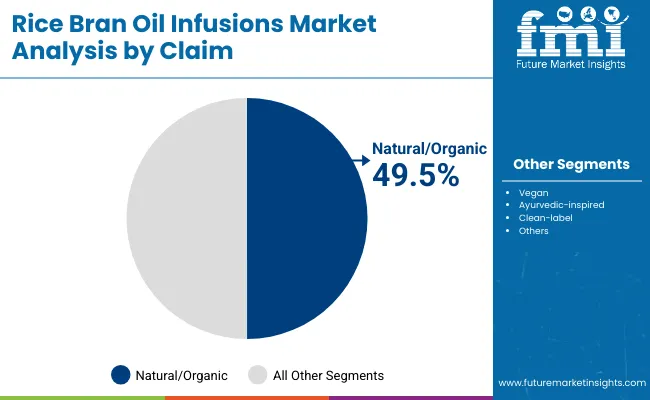
| Claim | Value Share% 2025 |
|---|---|
| Natural/organic | 49.5% |
| Others | 50.5% |
The Natural/Organic segment is forecasted to hold 49.5% of the Rice Bran Oil Infusions Market in 2025 (USD 574.7 million), reflecting strong consumer demand for clean-label skincare products. These formulations are favored for their transparency, free-from positioning, and alignment with rising health-conscious lifestyles. The category is further supported by certifications and labeling standards that boost consumer trust in both domestic and export markets.
Growth is bolstered by premium positioning across pharmacies, e-commerce, and specialty beauty stores, where natural and Ayurvedic-inspired blends carry higher margins. Brands are investing in alcohol-free preservation techniques and hybrid botanical infusions that strengthen the natural profile of their products. As consumers increasingly prioritize ingredient safety and authenticity, the natural/organic segment is expected to continue its momentum and emerge as the anchor for sustained expansion in the rice bran oil infusions category.
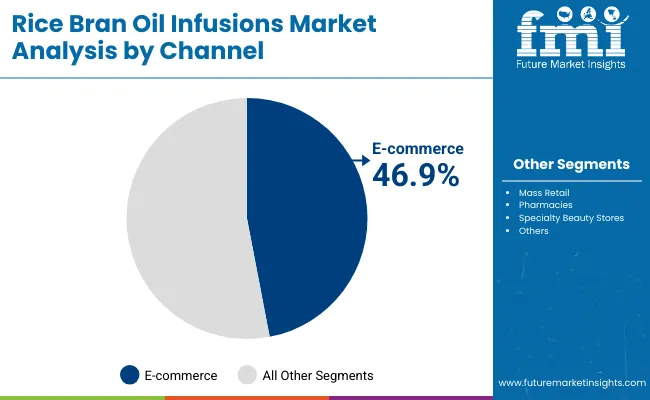
| Channel | Value Share% 2025 |
|---|---|
| E-commerce | 46.9% |
| Others | 53.1% |
The E-commerce segment is projected to account for 46.9% of the Rice Bran Oil Infusions Market in 2025 (USD 539.4 million), establishing itself as the fastest-growing distribution channel. Online platforms are preferred for their ability to deliver direct-to-consumer access, product transparency, and convenient delivery, making them especially attractive to younger consumers.
The segment’s growth is also supported by digital-first launches, influencer-led campaigns, and subscription models, which enhance consumer engagement. As demand for natural, organic, and Ayurvedic-inspired blends increases, e-commerce platforms have become the go-to channel for brands to test and scale innovative products. Given its scalability and alignment with digital beauty trends, e-commerce is expected to continue expanding its share of the Rice Bran Oil Infusions Market through 2035.
Surge in Demand for Natural and Ayurvedic Skincare
The rise of Ayurvedic-inspired beauty and herbal skincare is a key growth driver for rice bran oil infusions. With consumers in Asia-Pacific and global wellness markets prioritizing natural remedies, rice bran oil’s moisturizing and antioxidant properties are being positioned as safer, plant-based alternatives to synthetic skincare ingredients. This alignment with cultural traditions, especially in India and China, enhances product authenticity and boosts consumer trust, pushing demand across both premium and mass-market segments.
Expansion of E-Commerce and Digital Beauty Platforms
E-commerce accounts for 46.9% of the market in 2025, making it a central growth engine. The digital-first strategy enables brands to launch innovative rice bran oil infusions with minimal barriers, leveraging influencer marketing, subscription boxes, and AR-driven product trials. Younger demographics in Asia and North America prefer purchasing clean-label and vegan skincare online, driving faster adoption. This digital ecosystem also accelerates feedback loops, allowing brands to tailor infusions to consumer needs quickly and cost-effectively, strengthening long-term growth momentum.
High Cost of Certification and Regulatory Compliance
A major restraint in the rice bran oil infusions market is the expense associated with securing natural/organic, vegan, and clean-label certifications. Regulatory compliance varies by region, with strict requirements in the European Union and Japan. These costs add to manufacturing overheads, making certified products less competitive in price-sensitive markets. Smaller and emerging brands struggle to meet certification demands, limiting their ability to compete with established players. This cost burden slows penetration, especially in developing economies where affordability is critical.
Hybrid Formulations with Botanical Blends
A growing trend is the blending of rice bran oil with botanicals such as aloe vera, chamomile, and turmeric to enhance multifunctionality. These hybrid formulations appeal to consumers seeking targeted benefits like soothing, brightening, and anti-aging within one product. Such innovations are gaining momentum in premium skincare lines across Asia and Europe, where heritage botanicals reinforce brand narratives. This trend also supports premium pricing strategies, as consumers perceive botanical combinations as holistic solutions, ensuring both functional diversity and brand differentiation.
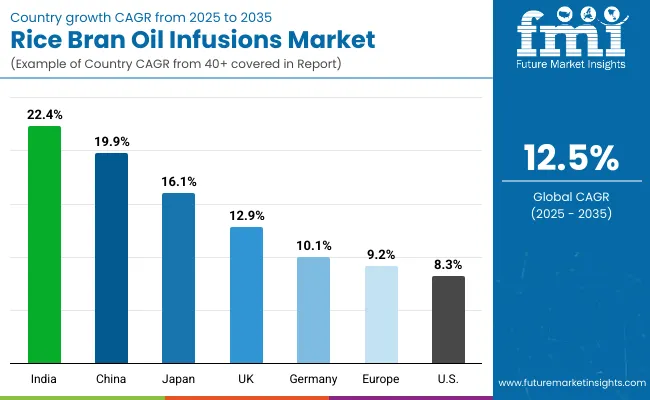
| Countries | Estimated CAGR (2025 to 2035) |
|---|---|
| China | 19.9% |
| USA | 8.3% |
| India | 22.4% |
| UK | 12.9% |
| Germany | 10.1% |
| Japan | 16.1% |
Asia-Pacific emerges as the fastest-growing region, anchored by China at 19.9% CAGR and India at 22.4% CAGR. This acceleration is driven by rising adoption of Ayurvedic-inspired formulations in India and the dominance of natural/organic claims in China, already accounting for more than half of value sales. India’s trajectory reflects a surge in wellness-led personal care adoption, while China benefits from expanding e-commerce penetration and premium skincare innovation.
Europe maintains a strong growth profile, led by Germany at 10.1% CAGR and the UK at 12.9% CAGR, supported by stringent organic certification requirements and a consumer base willing to pay premiums for natural formulations. European demand is anchored in pharmacy and specialty store channels, reinforcing brand trust and quality standards. Japan advances at 16.1% CAGR, driven by consumer focus on skin barrier repair and hybrid brightening formulations. Its innovation-led skincare culture accelerates premium adoption of rice bran oil infusions, with local brands integrating the ingredient into high-value creams and serums.
North America shows moderate expansion, with the USA at 8.3% CAGR, reflecting maturity in the skincare sector but steady interest in clean beauty and organic oils. Growth is more channel-driven, with e-commerce and digital-first indie brands outperforming traditional mass retail, while moisturizing-focused products continue to anchor category sales.
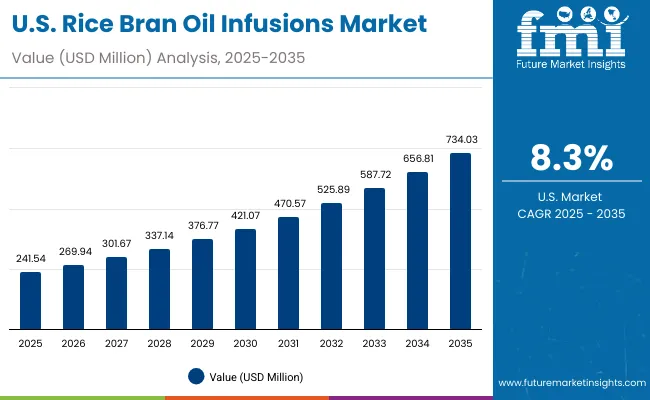
| Year | USA Rice Bran Oil Infusions Market (USD Million) |
|---|---|
| 2025 | 241.54 |
| 2026 | 269.94 |
| 2027 | 301.67 |
| 2028 | 337.14 |
| 2029 | 376.77 |
| 2030 | 421.07 |
| 2031 | 470.57 |
| 2032 | 525.89 |
| 2033 | 587.72 |
| 2034 | 656.81 |
| 2035 | 734.03 |
The USA Rice Bran Oil Infusions Market is projected to grow at a CAGR of 8.3% between 2025 and 2035, rising from USD 241.54 million in 2025 to USD 734.03 million in 2035. Growth is led by increasing consumer preference for moisturizing formulations, which account for 55.2% of USA sales (USD 133.2 million) in 2025. E-commerce continues to play a transformative role, enabling direct-to-consumer strategies and the rise of clean-label, vegan, and Ayurvedic-inspired blends.
Key drivers include strong adoption in the natural/organic skincare segment, demand for daily-use moisturizers and barrier-repair creams, and rising penetration of digital beauty platforms that allow product personalization. Mass retail and pharmacies remain important, but digital-first brands are gaining share rapidly, particularly among younger USA consumers who prioritize sustainability and transparency.
The Rice Bran Oil Infusions Market in the United Kingdom is expected to grow at a CAGR of 12.9% between 2025 and 2035, supported by rising demand for clean-label, vegan, and natural skincare formulations. UK consumers show strong preference for certified organic products, with pharmacies and specialty beauty stores driving premium adoption. Growth is also influenced by increasing popularity of Ayurvedic-inspired blends and hybrid moisturizers and brightening formulations. The UK’s emphasis on sustainability and cruelty-free standards positions it as one of the most attractive European markets for rice bran oil infusions.
India is witnessing rapid growth in the Rice Bran Oil Infusions Market, which is forecast to expand at a CAGR of 22.4% through 2035. This acceleration is fueled by strong consumer acceptance of Ayurvedic-inspired and herbal formulations, where rice bran oil is blended with turmeric, neem, and aloe vera for premium positioning. Rising demand in tier-2 and tier-3 cities reflects both affordability and increasing awareness of natural skincare. E-commerce platforms and specialty beauty outlets are extending access, driving nationwide adoption.
The Rice Bran Oil Infusions Market in China is expected to grow at a CAGR of 19.9%, the highest among leading economies, expanding its global share from 11.1% in 2025 to 11.9% in 2035. In 2025, the market is valued at USD 128.85 million, supported by strong demand for natural/organic claims, which already hold 51.2% share (USD 66.0 million). The segment benefits from rising adoption of e-commerce, premium skincare launches, and clean beauty preferences.
China’s momentum is further strengthened by local innovation in Ayurvedic-inspired hybrids and the competitive rise of domestic beauty brands, which use affordable formulations and digital platforms to expand reach. Younger consumers, especially in tier-1 and tier-2 cities, are accelerating adoption of rice bran oil-infused moisturizers and brightening products. By 2035, China’s market size is projected to nearly quadruple, becoming a core hub for Asia-Pacific expansion.
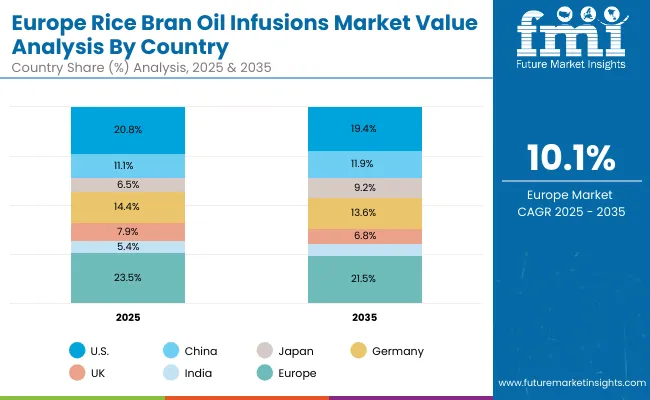
| Countries | 2025 Share (%) |
|---|---|
| USA | 20.8% |
| China | 11.1% |
| Japan | 6.5% |
| Germany | 14.4% |
| UK | 7.9% |
| India | 5.4% |
| Countries | 2035 Share (%) |
|---|---|
| USA | 19.4% |
| China | 11.9% |
| Japan | 9.2% |
| Germany | 13.6% |
| UK | 6.8% |
| India | 5.5% |
The Rice Bran Oil Infusions Market in Germany is projected to grow at a CAGR of 10.1% between 2025 and 2035, with its global share slightly adjusting from 14.4% in 2025 to 13.6% by 2035. Growth is supported by Germany’s established reputation for premium-quality skincare products, where consumer trust in certified organic and dermatologist-tested claims remains high. Rice bran oil infusions are gaining traction in moisturizing and skin-barrier repair segments, aligning with local demand for functional, science-backed formulations.
German consumers show strong adoption of natural/organic claims, reinforced by stringent EU certification requirements. Pharmacies dominate distribution, while specialty beauty stores and e-commerce channels are expanding their share, particularly among younger demographics. The market also benefits from Germany’s emphasis on sustainability, with brands innovating in alcohol-free preservation and hybrid botanical blends to meet clean-label expectations.

| USA Function | Value Share% 2025 |
|---|---|
| Moisturizing | 55.2% |
| Others | 44.8% |
The Rice Bran Oil Infusions Market in the United States is projected at USD 241.54 million in 2025, expanding to USD 734.03 million by 2035 at a CAGR of 8.3%. Growth is driven by rising consumer preference for moisturizing formulations, which lead with a 55.2% share (USD 133.2 million). Clean-label, vegan, and organic claims are steadily gaining traction, with USA brands emphasizing transparency and sustainability in formulations to align with consumer values.
The USA market is also supported by strong e-commerce penetration, where digital-first and indie skincare brands have widened access. Premium adoption is evident across pharmacies and specialty retailers, but digital channels are driving faster growth by targeting younger, eco-conscious demographics. As clean beauty frameworks expand and hybrid products incorporating rice bran oil with botanicals (like aloe and chamomile) gain attention, the USA market is expected to maintain steady expansion through 2035.

| China Claim | Value Share% 2025 |
|---|---|
| Natural/organic | 51.2% |
| Others | 48.8% |
The Rice Bran Oil Infusions Market in China is projected to grow at a CAGR of 19.9%, making it one of the fastest-growing global markets. In 2025, the market is valued at USD 128.85 million, with natural/organic claims leading at 51.2% (USD 66.0 million). This dominance reflects China’s strong consumer shift toward clean-label skincare, where authenticity, safety, and ingredient transparency are critical. The market benefits from an expanding e-commerce ecosystem, where premium and indie brands leverage digital-first launches, live-streaming sales, and influencer collaborations to capture young urban consumers.
Government-backed initiatives promoting natural formulations and rising disposable incomes in tier-1 and tier-2 cities further accelerate adoption. The market is also witnessing competitive momentum from domestic beauty brands, which are offering affordable yet certified natural infusions, boosting accessibility and mainstream use. Over the decade, China’s position as a hub for organic-certified and herbal-infused skincare will define its leadership in Asia-Pacific.
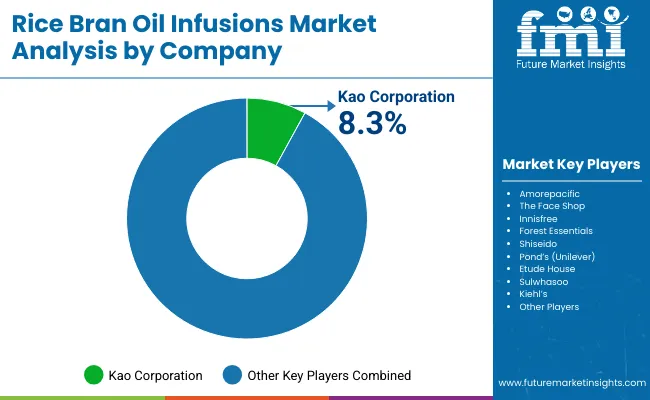
The Rice Bran Oil Infusions Market is moderately fragmented, characterized by a mix of global leaders, established regional players, and niche-focused skincare specialists. Kao Corporation, holding 8.3% global share in 2025, leads the competitive landscape through extensive product innovation in moisturizing and brightening formulations, coupled with strong brand equity in both Asia and Europe.
Mid-sized Asian beauty conglomerates such as Amorepacific, The Face Shop, Innisfree, and Shiseido are actively expanding their rice bran oil infusion portfolios, leveraging their expertise in herbal and hybrid skincare solutions. These companies are also strengthening their footprint in premium and mass-market channels, combining traditional wellness elements with modern cosmetic science. Niche-focused brands like Forest Essentials, Sulwhasoo, and Kiehl’s are gaining traction with Ayurvedic-inspired and natural formulations. Their competitive strength lies in premium positioning, digital-first strategies, and clean-label credentials, which resonate with wellness-oriented consumers in both mature and emerging markets.
Competitive differentiation is increasingly shifting from price and basic formulation to value-added claims, e-commerce agility, and sustainability positioning. Innovations in alcohol-free preservation, hybrid botanical blends, and eco-friendly packaging are becoming the central levers of competition.
Key Developments in Rice Bran Oil Infusions Market
| Item | Value |
|---|---|
| Quantitative Units | USD 1,163.4 Million |
| Function | Moisturizing, Brightening, Anti-aging, Skin barrier repair |
| Product Type | Oils, Creams/lotions, Serums, Masks |
| Channel | E-commerce, Mass retail, Pharmacies, Specialty beauty stores |
| Claim | Natural/organic, Vegan, Ayurvedic-inspired, Clean-label |
| Regions Covered | North America, Europe, Asia-Pacific, Latin America, Middle East & Africa |
| Country Covered | United States, Canada, Germany, France, United Kingdom, China, Japan, India, Brazil, South Africa |
| Key Companies Profiled | Kao Corporation, Amorepacific, The Face Shop, Innisfree, Forest Essentials, Shiseido, Pond’s (Unilever), Etude House, Sulwhasoo, Kiehl’s |
| Additional Attributes | Dollar sales by function and product type, adoption trends in natural/organic and Ayurvedic-inspired claims, rising demand through e-commerce and specialty beauty stores, sector-specific growth in personal care, wellness, and premium skincare, clean-label and vegan certification revenue segmentation, integration with AI personalization, AR/VR-enabled product trials, and digital platforms, regional trends inf luenced by Asia-Pacific growth and innovations in alcohol-free preservation, hybrid botanical blends, and eco-friendly packaging. |
The global Rice Bran Oil Infusions Market is estimated to be valued at USD 1,163.4 million in 2025.
The market size for the Rice Bran Oil Infusions Market is projected to reach USD 3,782.5 million by 2035.
The Rice Bran Oil Infusions Market is expected to grow at a 12.5% CAGR between 2025 and 2035.
The key product types in the Rice Bran Oil Infusions Market are Oils, Creams/Lotions, Serums, and Masks.
In terms of function, the Moisturizing segment is forecast to command the largest share in 2025, holding 52.5% of market value (USD 609.1 million).






Full Research Suite comprises of:
Market outlook & trends analysis
Interviews & case studies
Strategic recommendations
Vendor profiles & capabilities analysis
5-year forecasts
8 regions and 60+ country-level data splits
Market segment data splits
12 months of continuous data updates
DELIVERED AS:
PDF EXCEL ONLINE
Rice Water Skincare Market Forecast and Outlook 2025 to 2035
Rice Water Haircare Market Size and Share Forecast Outlook 2025 to 2035
Rice Shampoo Bar Market Size and Share Forecast Outlook 2025 to 2035
Rice Milling Machine Market Size and Share Forecast Outlook 2025 to 2035
Rice Mill Machine Market Size and Share Forecast Outlook 2025 to 2035
Rice Derivative Market Size and Share Forecast Outlook 2025 to 2035
Rice Polishing Machines Market Size and Share Forecast Outlook 2025 to 2035
Rice Water Shampoo Market Size and Share Forecast Outlook 2025 to 2035
Rice Processing Machine Market Size and Share Forecast Outlook 2025 to 2035
Rice Cake Market Analysis - Size, Share, and Forecast Outlook 2025 to 2035
Rice Milk Market Trends - Dairy-Free Nutrition & Industry Growth 2025 to 2035
Rice-based Products Market Analysis by Product Type, Distribution Channel, and Region Through 2035
Key Players & Market Share in Rice Water Haircare Sector
Market Share Breakdown of Rice Shampoo Bar Manufacturers
Rice Paper Stand Up Pouch Market Growth & Sustainable Packaging 2024-2034
Rice Protein Market
Rice Bran Fatty Alcohols Market Size and Share Forecast Outlook 2025 to 2035
Rice Bran Derivatives Market Size and Share Forecast Outlook 2025 to 2035
Rice Bran Wax Market Analysis - Size, Share, and Forecast 2025 to 2035
Rice Bran Oil for Skin Care Market Size and Share Forecast Outlook 2025 to 2035

Thank you!
You will receive an email from our Business Development Manager. Please be sure to check your SPAM/JUNK folder too.
Chat With
MaRIA